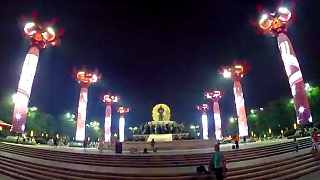
|
With Valeriy Blank ...
TongLiao travel guide
Introduction
TongLiao, located in eastern Inner Mongolia, is a vibrant city known for its rich cultural heritage, picturesque landscapes, and unique ethnic diversity. As a key city in the Inner Mongolia Autonomous Region, TongLiao offers a blend of Mongolian traditions and modern urban life. This guide will provide you with detailed information on the city's attractions, local cuisine, cultural highlights, and practical travel tips for an enjoyable visit to TongLiao.
Must-See Attractions
Dalelin Temple (大乐林寺)
Dalelin Temple is one of the most important Tibetan Buddhist temples in Inner Mongolia. This beautiful temple complex features stunning architecture, intricate murals, and serene courtyards. It is a place of worship and meditation, offering a peaceful retreat from the bustling city life.
Horqin Grassland (科尔沁草原)
The Horqin Grassland is a vast expanse of natural beauty, offering visitors a chance to experience the traditional nomadic lifestyle of the Mongolian people. Visitors can stay in yurts, ride horses, and enjoy the breathtaking scenery of rolling hills and endless plains. The grassland is especially beautiful during the summer when wildflowers are in full bloom.
Nadam Fair (那达慕大会)
The Nadam Fair is an annual festival celebrated by the Mongolian people, showcasing traditional sports such as horse racing, wrestling, and archery. The fair is a vibrant and colorful event, featuring traditional music, dance, and delicious local food. It is a fantastic opportunity to immerse yourself in Mongolian culture and traditions.
TongLiao Museum (通辽博物馆)
The TongLiao Museum is a great place to learn about the history, culture, and natural environment of TongLiao and the surrounding region. The museum's exhibits include ancient artifacts, traditional costumes, and displays on the local flora and fauna. It provides a comprehensive overview of the area's rich heritage.
Kulun Temple (库伦寺)
Kulun Temple, also known as the Temple of Ten Thousand Buddhas, is another significant Tibetan Buddhist temple in TongLiao. The temple is renowned for its impressive collection of Buddha statues and beautiful religious art. It is a serene and spiritual place, attracting both worshippers and tourists.
Local Cuisine
TongLiao's cuisine is a delightful blend of Mongolian and Chinese flavors, featuring hearty and savory dishes. Here are some must-try foods:
Roast Lamb (烤羊肉)
Roast lamb is a staple of Mongolian cuisine and a must-try when visiting TongLiao. The meat is marinated with spices and slow-roasted to perfection, resulting in tender and flavorful lamb that is often enjoyed with flatbread and fresh vegetables.
Milk Tea (奶茶)
Mongolian milk tea is a traditional beverage made with tea, milk, and salt. It has a unique and comforting flavor, often served with traditional snacks like cheese and bread. It is a perfect drink to warm you up on a chilly day.
Buuz (包子)
Buuz are steamed dumplings filled with minced meat, usually lamb or beef, and seasoned with onions and spices. These savory dumplings are a popular snack or meal, enjoyed for their rich taste and satisfying texture.
Cheese (奶酪)
Mongolian cheese, made from cow or goat milk, is a traditional food that comes in various forms, from hard and crumbly to soft and creamy. It is often enjoyed as a snack or used as an ingredient in other dishes.
Cultural Highlights
Traditional Mongolian Music and Dance
Traditional Mongolian music and dance are integral parts of the local culture in TongLiao. Performances often feature throat singing, horsehead fiddle (morin khuur), and lively dances that reflect the nomadic lifestyle and natural beauty of the grasslands. Attending a cultural performance is a wonderful way to experience the artistic heritage of the Mongolian people.
Ethnic Festivals
TongLiao hosts several ethnic festivals throughout the year, celebrating the customs and traditions of the Mongolian, Han, and other ethnic groups in the region. These festivals include music, dance, food, and various cultural activities, offering a vibrant and immersive cultural experience.
Handicrafts and Souvenirs
TongLiao is known for its traditional handicrafts, including embroidery, leather goods, and jewelry. Local markets and shops offer a variety of handmade items that make for unique souvenirs and gifts. These crafts reflect the artistic skills and cultural heritage of the local people.
Practical Travel Tips
Best Time to Visit: The best time to visit TongLiao is during the spring (April to June) and autumn (September to October) when the weather is mild and pleasant.
Getting Around: TongLiao has a well-developed public transportation system, including buses and taxis. Renting a car or hiring a local guide can also be a convenient way to explore the surrounding grasslands and attractions.
Language: Mandarin Chinese is the official language, but Mongolian is also widely spoken. English is not commonly spoken, so it's helpful to learn some basic Mandarin phrases or use a translation app.
Accommodation: TongLiao offers a range of accommodation options, from budget hotels to more upscale establishments. Staying in a yurt on the grasslands is a unique experience that provides a glimpse into the traditional Mongolian lifestyle.
Health and Safety: TongLiao is generally a safe city for travelers. However, it's advisable to take standard precautions, such as avoiding poorly lit areas at night and keeping an eye on your belongings.
Conclusion
TongLiao is a fascinating destination that offers a blend of rich cultural heritage, stunning natural landscapes, and unique ethnic traditions. Whether you're exploring its historic temples, enjoying the local cuisine, or experiencing the vibrant festivals, TongLiao provides a memorable and enriching travel experience. Use this guide to make the most of your visit to this captivating city in Inner Mongolia.
|
 Chinese Civilization – documentary
Chinese Civilization – documentary




